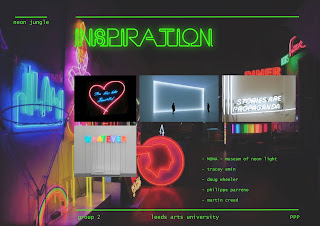After gathering all the information from the group, we were able to piece together everyones role into the presentation. Using the theme of neon jungle, we designed the presentation with this theme in mind.
Using the theme of neon lighting, we decided that the presentation would best represent this with a colourful aesthetic. This would give the viewers an idea of the type of signage found within our way finding system.
After explaining our concept to the viewers, the ideas were then explained and displayed through mock ups and similar inspirations.
By involving the colour scheme within the presentation, it was possible to explain how each colour correlates to specific subjects taught in LAU. This way the audience can understand which colours to look for on the map.
Explaining the formats that the project intends to take was the next step in communicating our idea. This would allow viewers to imagine how each sign may look when it is displayed within the way finding system.
Further justification was then added to back up our ideas and reasons for choosing 'neon jungle' as our theme. This would include how it would work and what makes it a suitable theme for the university. As we believe colour can represent creativity, this was our reasoning behind 'neon jungle'.
The map for the way finding system was then explained and inspirations for the project would identify where our idea came from. As the project would aim to appeal to students between 18 and 24, we believe that by looking at venues attended by students would influence the design of our own project. To this end, we found that many independent student venues would often use neon lights for decorative purposes, which would reflect a creative atmosphere for visitors.
As a result of the presentation, we were able to understand the ways in which to present to the audience, how the concept could be proposed and why it would work for this particular project. Upon receiving feedback from peers, we were also able to identify areas that could have been improved and ways in which to approach a similar task in future.











No comments:
Post a Comment